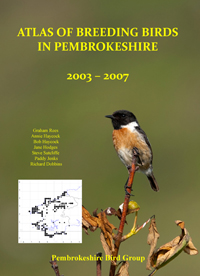Some twelve good men and true were gathered hopefully within the Strumble look-out, gazing out to sea, scanning for seabirds on 4th October. Suddenly, at about 11:10hrs (who said all rare birds come at dawn?), Stephen Berry, of nearby Tresinwen, "called" an approaching bird, his tone and demeanour clearly indicating a good one! So it proved to be, for as it came closer and could be compared with nearby Manx Shearwaters, it was evident that most of us had seen little quite like it before. At its closest it could have been as near as 400m from our position; it was well seen.
Identification was not too difficult, for in recent months we have all been treated to well-illustrated articles in birding journals, depicting Soft-plumaged Petrels. Perhaps the real question was, is it possible to reduce the super-species to Pterodromoa feae, which the writer thinks it was?
The bird provided us with splendid views and indulged in interesting flight patterns, as it prospected for food, quartering the sea. From the peak height of its flight, it would rapidly plane downwards, then swoop up, buoyantly rising and falling dramatically in arcs and parabolas. It alighted on the sea once or twice and was clearly feeding. On two occasions it turned and flew rapidly on a straight low course for some 30m or so, as though it had located prey items. It jinked sideways at times, towered and produced an almost umbrelloid wing arching when really low over the sea. It left us after some 10 minutes, leaving us "enthusiastically hysterical", so just imagine our amazement when it returned again and again, giving us three "bites at the cherry". It returned at 13:35 hrs (spotted by Hywel Roderick) and again at 14:45 hrs (located by Graham Rees, who sadly missed the initial, closest viewing). Total viewing time must have amounted to 20 minutes or more.
Importantly, GHR'S reaction on seeing the bird, caused him to say that the one minute viewing, same location on 6th October 1990, by he, Richard Davies, Peter Murray and Jim Poole, of a similar bird, left him in no doubt that he had now seen his second Pembrokeshire Soft-plumaged Petrel. BBRC, however, have failed to accept this earlier record on the ground of limited opportunity to ascertain all the essential details.
Steve Berry’s field notes include:
Head: showed an indistinct cap when looked for, smudgy dark patch around eye
Body: very short-necked with an incomplete collar, undersides very clean white, upperparts of body greyish
Wings: appeared very far forward, giving a short-necked appearance. Wings very pointed, primaries dark, paler secondaries. In good light, showed a distinct "M" across the upperwing. Underwing mainly dark but showed pale area on coverts.
Tail: upper tail and rump paler than mantle, Underside as white as body
I would add that the bird was roughly the size of Manx Shearwater, but its shape was different, having a long tapering tail and the wings seemed placed well forward compared to Manx's halfway along the body.
Among those present were: Stephen Berry (who first located it), Jack Donovan (who first dared to identify it), Stuart Devonald (who saw it all), Graham Rees (who enjoyed two of the three sightings), Cliff Benson (who had not travelled too far), Peter Murray (rewarded for his journey from Maesteg), Howel Roderick (whose written account was first class) and Graham Walker (able to show it to his visitors).
A memorable even indeed and the important sequel was notification of acceptance by BBRC on 2 March 1997
Jack Donovan

Pterodroma feae and P.madeira are a complex species pair, perhaps doubtfully separable in the field. These two species form part of a super-species, along with the Soft-plumaged Petrel (P.mollis) of the southern oceans. Fea's Petrel breeds on the Desertas, offshore islets of Madeira, the Cape Verde islands and possibly the Azores, with a total population of about 450 pairs. The other N Atlantic population amount to perhaps 30 pairs, is known as Zino's Petrel and breeds on Madeira. The Strumble bird was either Fea's or Zino's Petrel, lacking the breast band of P.mollis.
Pembrokeshire Bird Report 1996
British Birds, August 2006. p404-419
Although it has proved impossible to assign any of these individuals (all soft-plumaged petrels recorded in British waters) to one particular species with complete confidence, the weight of evidence suggests that the well-observed British records of ‘soft-plumaged petrels’ refer to Fea’s Petrel.
There is no evidence at all of birds showing features suggestive of Soft-plumaged Petrel in British waters. Although it is a much more difficult problem, there is also nothing specific to suggest that Zino’s Petrel has occurred either. Even where there are minor anomalies relating to one feature in a description, these are either contradicted by another observer’s description, or occur where there are other features strongly suggesting Fea’s Petrel.
Although it is quite possible that either or both of the other species might occur, there is nothing specific to suggest that any of the British records so far might relate to one of them. This is quite different from saying that any of the earlier records are acceptable as the first Fea’s Petrel for Britain; this requires a higher level of proof that is simply not available. Until such time as there is clearly documented evidence of individual records, or a number of observations of birds displaying features that contradict the established characters, it is probably reasonable for most observers to assume that a ‘soft-plumaged petrel’ seen around Britain’s coast is likely to be Fea’s Petrel. This is not only because Zino’s Petrels are so rare, but also because the weight of documented evidence, where it exists, is consistent with our current knowledge of Fea’s Petrel, the one species which has been proved to occur.
 Tuesday, March 6, 2018 at 11:13AM
Tuesday, March 6, 2018 at 11:13AM  Pembrokeshire Avifauna committee | Comments Off |
Pembrokeshire Avifauna committee | Comments Off |  BBRC,
BBRC,  Rarity in
Rarity in  Fea's/Zino's Petrel
Fea's/Zino's Petrel 


